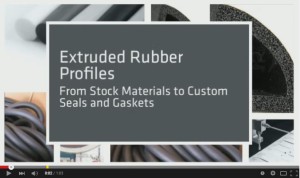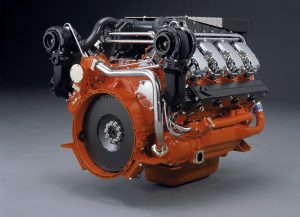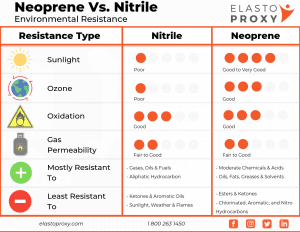
Learn how extruded rubber profiles are made, and how custom fabrication converts elastomeric stock materials into specialty seals and custom gaskets. Click here for Elasto Proxy’s catalog of standard profiles.
Rubber extrusion is a manufacturing process that creates stock materials or profiles with a fixed cross-section such as a U-shaped channel. First, uncured elastomers are pushed or drawn through a specialized metal tool called a die. Later, the rubber compound is cured through vulcanization, a chemical conversion process that uses heat and sulfur to impart durability and improve mechanical properties.
Rubber extrusion is used with many different types of elastomers, and this rubber manufacturing method supports complex cross-sectional profiles with an excellent surface finish. Because extrusion mixes and blends the raw materials, the cured rubber offers consistent strength and a uniform appearance along the length of the profile. Standards from the Rubber Manufacturers Association (RMA) define part tolerances based on physical dimensions and an RMA class of high precision, precision, or commercial.
Extruding Stock Materials
Extruded rubber can be vulcanized through static or continuous methods involving hot air, an autoclave or microwave, or a salt tank. Static vulcanization conveys extrusions to a workstation where rubber is cut-to-length and then placed on a metal pan for curing. By contrast, continuous vulcanization feeds the rubber extrusion directly from the extruder to the vulcanizing equipment.
Suppliers of rubber profiles offer products in fixed lengths, but these stock materials may be longer than your application requires. By working with a custom fabricator, however, you can source the part lengths you need. For example, water jet cutting converts stock materials to size by making fine, fast, accurate cuts. No tooling is required, and this cost-effective cutting technique is ideal both for prototyping and low-to-medium volume production.
Custom Fabrication: Cutting, Splicing, and Taping
As an experienced custom fabricator of industrial rubber products, Elasto Proxy keeps hundreds of extruded profiles in stock and cuts them to size with Ingersoll-Hand heads that direct water-jets of 50,000 pounds per square inch. Unlike saw or guillotine cuts, water jet cutting won’t create beveled edges either. Smooth edges are easier to bond, and available joining techniques include film splicing, cold bonding, C-press injection molding, and vulcanizing.
Elasto Proxy also offers taping services for sealing solutions that are ready right out-of-the-box. When our bonded gaskets or gluing gaskets arrive on your factory floor, workers can simply read the part labels, remove the plastic backing, and stick on the gasketing. There’s no need to install screws, make additional cuts, or slow down the assembly line. If you’re serious about lean manufacturing and eliminating muda (waste), try taped gaskets for your next project.
Get Elasto Proxy’s Catalog
Custom fabrication is critical, but technical buyers and product designers must first select the type of rubber profile that’s right for the application. So what’s the best way to get started? Download Elasto Proxy’s catalog and find solid profiles such as bumpers, C-channels, E-strips, glazing seals, J-seals, P-strips, quad, square and round cords, tubing, U-channels, strips, locking and self-locking channels, and zipper strips.
Elasto Proxy’s catalog of industrial rubber products also features sponge profiles in a variety of elastomers and durometers. Depending on your application requirements, choose accordion seals, bulb seals, door seals, D-strips, lip seals, and sponge cord. Lengths of industrial tubing can be cut into tube rings, and the air that’s trapped inside acts as a shock absorber to aid in recovery. To get start with your custom-fabricated solutions, download our catalog.
Download the Product Catalog











